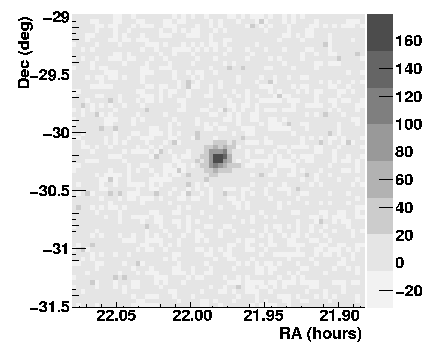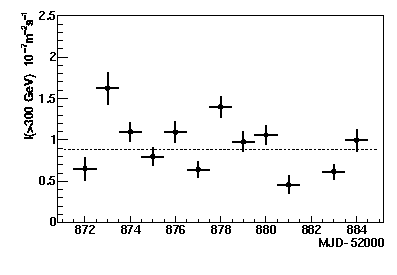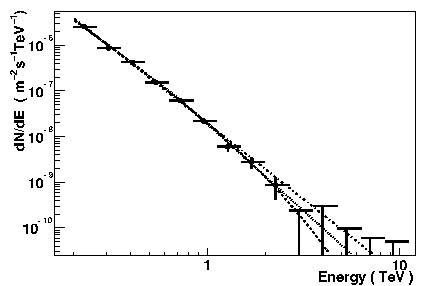The Active Galaxy PKS 2155-304
November 2004
At a redshift of 0.12, the Active Galactic Nucleus (AGN) PKS 2155-304 is one of the most distant well-established sources of TeV gamma rays, together with the source H 1426+428 at a redshift of 0.13. The high-frequency peaked BL Lac-type object was first discovered by the HEAO-1 X-ray satellite (see also here), and is now known to be one of the brightest extragalactic X-ray sources in the sky. It is associated with a compact, flat-spectrum radio source and exhibits an essentially featureless continuum from radio to X-ray frequencies. Gamma ray emission in the energy range from 30 MeV to 10 GeV was detected by the EGRET detector aboard the Compton Gamma Ray Observatory. PKS 2155-304 is well studied and has a history of strong broad-band variability. At TeV energies, PKS 2155-304 was first detected in 1999 by the Durham telescopes, with a statistical significance of 6.8 standard deviations.
PKS 2155-304 was among the initial targets to be observed with the H.E.S.S. instrument, and already data taken with the first telescope in July and October 2002 revealed a clear TeV signal. PKS 2155-304 was since observed extensively with H.E.S.S., accumulating well over 100 h of exposure, partly in the context of multiwavelength campaigns. A positive detection was achieved in essentially each (4-week) observation period (Fig. 1); by 2004, the detection has reached a statistical significance of over 100 standard deviations. The TeV flux exhibits significant variability, both on long-term (months) and short-term (days (Fig. 2) and hours) time scales.
At the large distance to PKS 2155-304, the TeV radiation is significantly attenuated due to interactions of TeV gamma rays with the extragalactic background light (EBL), resulting in electron-positron pair creation. Depending on the assumption for the (in the relevant wavelength regime poorly known) EBL intensities, attenuation at TeV energies ranges from a factor 10 to 100. The relatively steep TeV gamma-ray energy spectrum measured by H.E.S.S. with a spectral index of 3.3+/-0.1 (Fig. 3) presumably reflects the attenuation, which increases with energy. The well-measured spectrum will help to constrain EBL models. So far, the only objects which have been studied with comparable precision are the AGNs Markarian 421 and 501, which are much closer, at a redshift around 0.03.
References
H.E.S.S. observations of PKS 2155-304, H.E.S.S. collaboration, F. Aharonian et al., Astron. Astrophys. 430 (2005) 865-875
Multi-wavelength observations of PKS 2155-304 with H.E.S.S, H.E.S.S. collaboration, F. Aharonian et al. A&A, in press


